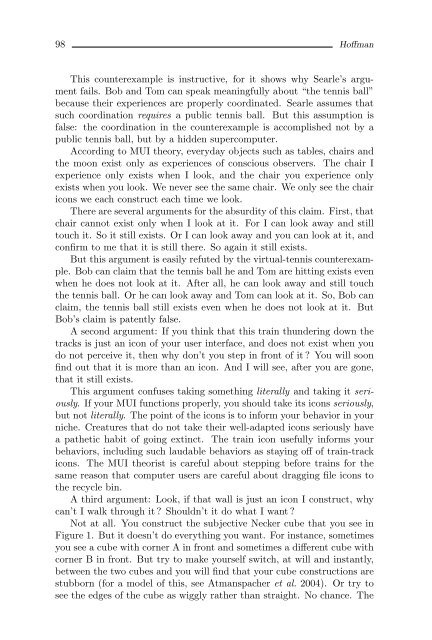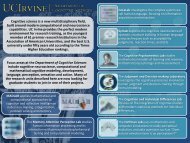Conscious Realism and the Mind-Body Problem - UCI Cognitive ...
Conscious Realism and the Mind-Body Problem - UCI Cognitive ...
Conscious Realism and the Mind-Body Problem - UCI Cognitive ...
Create successful ePaper yourself
Turn your PDF publications into a flip-book with our unique Google optimized e-Paper software.
98 HoffmanThis counterexample is instructive, for it shows why Searle’s argumentfails. Bob <strong>and</strong> Tom can speak meaningfully about “<strong>the</strong> tennis ball”because <strong>the</strong>ir experiences are properly coordinated. Searle assumes thatsuch coordination requires a public tennis ball. But this assumption isfalse: <strong>the</strong> coordination in <strong>the</strong> counterexample is accomplished not by apublic tennis ball, but by a hidden supercomputer.According to MUI <strong>the</strong>ory, everyday objects such as tables, chairs <strong>and</strong><strong>the</strong> moon exist only as experiences of conscious observers. The chair Iexperience only exists when I look, <strong>and</strong> <strong>the</strong> chair you experience onlyexists when you look. We never see <strong>the</strong> same chair. We only see <strong>the</strong> chairicons we each construct each time we look.There are several arguments for <strong>the</strong> absurdity of this claim. First, thatchair cannot exist only when I look at it. For I can look away <strong>and</strong> stilltouch it. So it still exists. Or I can look away <strong>and</strong> you can look at it, <strong>and</strong>confirm to me that it is still <strong>the</strong>re. So again it still exists.But this argument is easily refuted by <strong>the</strong> virtual-tennis counterexample.Bob can claim that <strong>the</strong> tennis ball he <strong>and</strong> Tom are hitting exists evenwhen he does not look at it. After all, he can look away <strong>and</strong> still touch<strong>the</strong> tennis ball. Or he can look away <strong>and</strong> Tom can look at it. So, Bob canclaim, <strong>the</strong> tennis ball still exists even when he does not look at it. ButBob’s claim is patently false.A second argument: If you think that this train thundering down <strong>the</strong>tracks is just an icon of your user interface, <strong>and</strong> does not exist when youdo not perceive it, <strong>the</strong>n why don’t you step in front of it ? You will soonfind out that it is more than an icon. And I will see, after you are gone,that it still exists.This argument confuses taking something literally <strong>and</strong> taking it seriously.If your MUI functions properly, you should take its icons seriously,but not literally. The point of <strong>the</strong> icons is to inform your behavior in yourniche. Creatures that do not take <strong>the</strong>ir well-adapted icons seriously havea pa<strong>the</strong>tic habit of going extinct. The train icon usefully informs yourbehaviors, including such laudable behaviors as staying off of train-trackicons. The MUI <strong>the</strong>orist is careful about stepping before trains for <strong>the</strong>same reason that computer users are careful about dragging file icons to<strong>the</strong> recycle bin.A third argument: Look, if that wall is just an icon I construct, whycan’t I walk through it ? Shouldn’t it do what I want ?Not at all. You construct <strong>the</strong> subjective Necker cube that you see inFigure 1. But it doesn’t do everything you want. For instance, sometimesyou see a cube with corner A in front <strong>and</strong> sometimes a different cube withcorner B in front. But try to make yourself switch, at will <strong>and</strong> instantly,between <strong>the</strong> two cubes <strong>and</strong> you will find that your cube constructions arestubborn (for a model of this, see Atmanspacher et al. 2004). Or try tosee <strong>the</strong> edges of <strong>the</strong> cube as wiggly ra<strong>the</strong>r than straight. No chance. The







